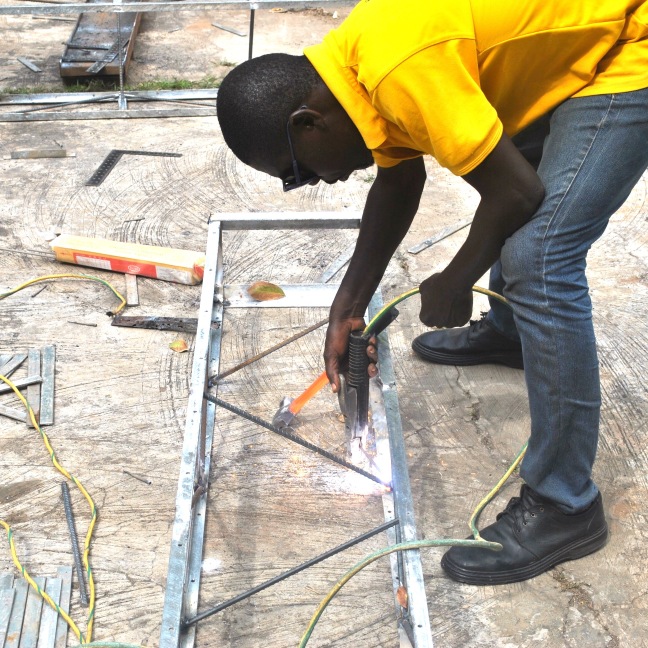









Mild steel angle bar is liable to twist or bend before the truss is triangulated; to ensure that each octet truss you make is straight (±1 mm) use a straight and square metal jig with wood board forming welding bed (will burn over time, flip over before replacing). Use clamps to secure 2d truss frame to jig, and push metal against wood plate of jig with a nonconductive pipe or wood stick.
Welding: Tack weld first throughout to assemble octet truss, then complete full weld once all metal elements are held in contact. Usually a small amount of grinding required to clear sharp edges. Apply hardener coat to seal and spray 3-6 coats of automotive paint. Paint damage possible (e.g. scratches) during transport and assembly; paint touch-up work may be done after assembly.



Fabrication of a semi-octet truss using 1 or 1-1/2 inch mild steel angle bar requires use of several jigs: 2d truss jig, square pyramid jig, and spacers for setting flat bar and holding string line to gauge top angle bar when welding. Each truss comprises 16 square pyramids of 4 pcs 10 or 12 mm by 16.85 cm iron rods welded to a linear array of 19.6 cm flat bar straps set in a 1 or 1-1/2 inch ms angle bar frame 20 cm wide by 282.5 cm long.
Welding: Tack weld first throughout to assemble octet truss, then complete full weld once all metal elements are held in contact. Usually a small amount of grinding required to clear sharp edges. Apply hardener coat to seal and spray 3-6 coats of automotive paint. Paint damage possible (e.g. scratches) during transport and assembly; paint touch-up work may be done after assembly.
To assembly a semi-octet truss, you will need: 2d truss jig and square pyramid jig.



Three (3) welded steel box trusses required for this floor assembly.




 on flat and level ground surface, weld pair of 2d trusses together with 1-1/2in angle bar at top and bottom corners.
on flat and level ground surface, weld pair of 2d trusses together with 1-1/2in angle bar at top and bottom corners.



Making a mobile oven, or mini-kiln; for melting plastics originally but whatever you need to bake. Pick or make the right caster wheels for the sort of mobility mini-kiln usage requires.


Plastics constitute a significant portion of the Agbogbloshie waste stream, moving through stages of collection, sorting (by type and colour), cleaning, shredding and even in some cases molding into pellets. (See Plastics blog post). With at least 7 micro-factories by our count, Agbogbloshie is a key part of the plastic recycling industry in Ghana, and integrally interconnected with both local and global production cycles. To date, the failure of Agbogbloshie’s industrial ecosystem to add value to plastic material recycled on-site is a lost opportunity for local manufacturing.
Building on our experiments with plastic during AMPQAMP and drawing on the knowledge and expertise of oven fabricators based on the ground in Agbogbloshie, we are now co-designing and prototyping a mini-kiln. This week, William Mensah completed fabrication of the first prototype in Accra Timber Market,adjacent to Agbogbloshie. The mini-kiln fits the standard module of the AMP spacecraft and is one of the first tools from the AMP tool-set developed to plug into the community workshop.

The prototype, is composed essentially of a frame of angle bars, inner and outer layers of sheet metal with a layer of what is locally called “fibre” (PUR foam insulation sourced from air-conditioner dismantling). We didn’t finish until evening, but couldn’t wait to test. Hence using shredded plastics from Agbogbloshie, we made new recycled plastic tiles, heating the the plastics to their melting point, and allowing them to cool. We intend to carry out carry more of such low-high tech plastic experiments soon in our spacecraft. Stay tuned for more and be sure to share with us, your innovative ideas regarding plastic recycling.

Notes:
+Need to add chimney, temperature gauge, and calibrated gas control.
+Cost compare with 2-module wide unit, cylindrical drum cast concrete or clay insulated.
+Link with rotational plastics moulding machine:feedback-enabled temperature controls.